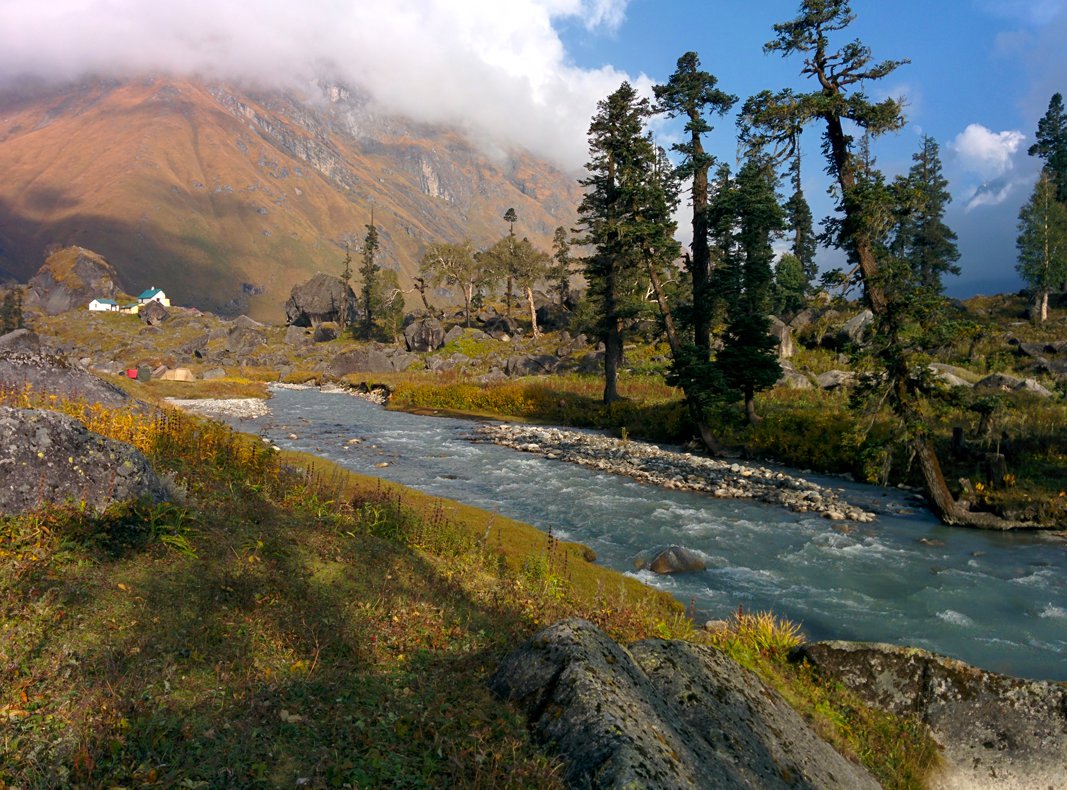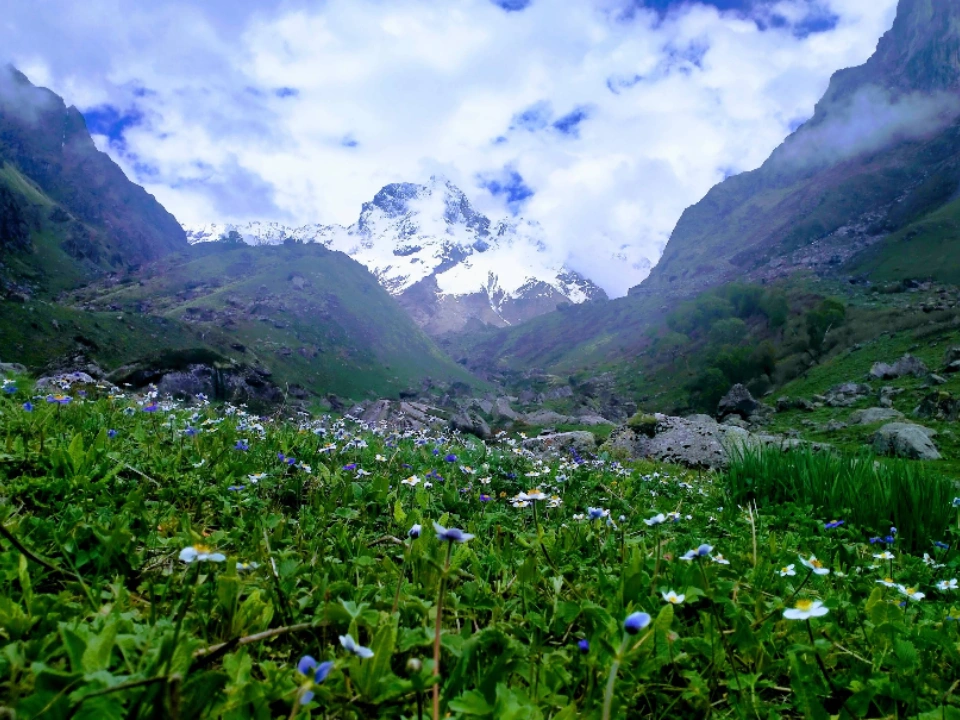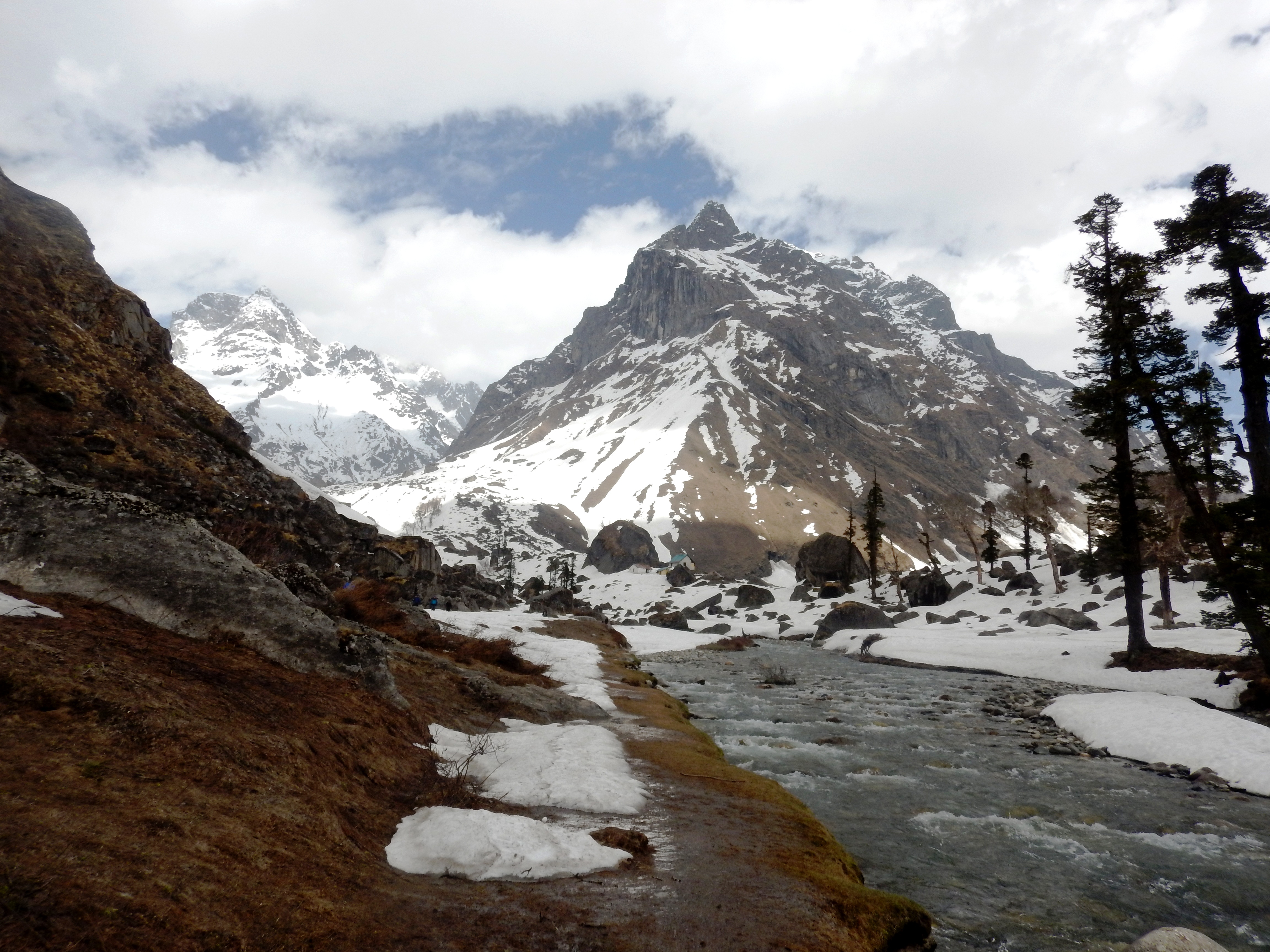Har Ki Dun Weather Guide 2025 – Best Time, Temperature & Seasonal Travel Tips
Published on November 08, 2025
Har Ki Dun Valley in Uttarakhand is a legendary cradle-shaped valley rising to about 11,600 feet in the Govind Wildlife Sanctuary. Surrounded by the Swargarohini and Black Peak ranges, this valley holds sacred significance stemming from its mention in the Mahabharata and is often called the “Valley of Gods.” The trail is rich in Himalayan scenery, village culture, rivers, and forests, making it one of the most celebrated offbeat Himalayan treks. Known for its changing landscapes, Har Ki Dun trek is suitable for nature lovers, adventure seekers, and trekkers of all experience levels.
From Dehradun or via a Har Ki Dun Package, the journey typically begins at Sankri, passing through riverside villages like Taluka, Osla, and Gangaad. Along the path, trekkers enjoy views of alpine meadows, dense deodar and pine forests, wildflower-filled clearings, and lingering snow patches during late spring and winter. Har Ki Dun Valley is also renowned for its birdlife, traditional villages, and the welcoming culture of Uttarakhand—experienceable through a guided Har Ki Dun trekking tour or travel deal that offers all logistical support and insights from local guides.
Trekking Har Ki Dun offers natural beauty and season-specific adventures. Whether you book Har Ki Dun trek from Delhi, choose a full Har Ki Dun package, or work with local Uttarakhand trekking operators, you’re in for an extraordinary experience across every season. Combine your Har Ki Dun trip booking with these practical weather insights for a memorable, safe, and seamless journey into the heart of the Garhwal Himalayas.

Har Ki Dun Weather Month-by-Month
Har Ki Dun’s weather dramatically shapes the trek experience. Here’s a summary of typical conditions across the months:
| Month | Temperature (°C) | Weather Highlights |
|---|---|---|
| March - April | 2 – 10 (day) | Spring blooms, chilly nights, clear views |
| May - June | 6 – 18 (day) | Lush meadows, mild, occasional rain |
| July - Aug | 7 – 15 (day) | Monsoon, heavy rain, lush but slippery |
| Sept - Nov | 5 – 14 (day) | Clear skies, golden landscapes, cold nights |
| Dec - Feb | -8 – 8 (day) | Heavy snow, white valley, coldest season |
Night temperatures can fall below freezing from November through March, while daytime weather remains pleasant from late April through June.
Best Time to Visit Har Ki Dun
The best time to visit Har Ki Dun and book a Har Ki Dun trek depends on your weather and scenery preferences. For lush greenery, book between mid-April and June. For golden-brown meadows, post-monsoon trekking (September to November) is ideal. Winter months (December to February) transform the valley into a snowy panorama, appealing to those looking for snow adventure.
Summer is the safest and most popular for families and first-time trekkers, while autumn guarantees clear Himalayan vistas. Avoid the core monsoon season (late July to early September) due to slippery paths and landslide risks, though some Har Ki Dun packages offer monsoon specials for experienced trekkers seeking isolation and unique valley colors.
Spring Season (March–April): Blossoms & Clear Skies
Spring in Har Ki Dun breathes new life into the valley. As snow melts, trails are flanked by blooming rhododendrons, wild orchids, and green shoots. Mornings are crisp, days are sunny, and the air feels especially clean. This is an excellent time for photography and wildlife spotting, and most Har Ki Dun package providers start their trekking tours by late March. Nights tend to be cold, sometimes dipping below 0°C, but mornings promise brilliant blue skies and dramatic mountain backdrops.
Beginner trekkers should book Har Ki Dun trek packages that include warm camps and experienced guides to ensure comfort and safety.

Summer Season (May–June): Pleasant and Green
Summer brings out the lushest side of Har Ki Dun. Day temperatures rise to a comfortable 15–18°C, with clear skies and snow remaining only at higher altitudes. The valleys are thick with wildflowers, and rivers flow swiftly. These months are prime for Har Ki Dun trekking tours—routes are accessible, and accommodations are plentiful.
Streams and waterfalls are at their peak, and the villages along the way buzz with activity. Flies and bugs can be bothersome in wetter spots, so packing repellent is wise. If you’re looking for a classic Uttarakhand trekking package with child-friendly conditions and fewer gear requirements, this is your season.
Monsoon Season (July–August): Pros & Cons
Monsoon is both beautiful and challenging in Har Ki Dun. Rain revives the valley, saturating every vista with shades of green and feeding the Supin River. However, slippery trails, potential landslides, and leeches make paths tricky.
Most guided Har Ki Dun trek or group deals pause operations during peak rains, but some adventurous packages run for experienced trekkers, focusing on safe windows in early July or late August. Those booking Har Ki Dun trek in the monsoon should ensure weather insurance and flexible plans. While crowd-free, these months require extra caution for safety and awareness of local advisories.
Autumn (September–November): Golden Valley Views
Autumn is a magical time to explore Har Ki Dun—crisp weather, dry paths, and crystal-clear Himalayan views. The valley transforms into swathes of gold and bronze, making every step photogenic. Daytime is comfortably cool (10–14°C), but nights grow cold, often below freezing by late November.
This period is beloved by photographers and trekkers seeking solitude without the heavy snow of winter or the humidity of summer. Har Ki Dun itinerary options in autumn are among the most flexible, with clear trails and little risk of travel disruption. Book Har Ki Dun trek tour deals early, as this period is in high demand before cold weather returns.
Winter Season (December–February): Snow Adventure
For trekkers dreaming of a white Himalayan adventure, winter in Har Ki Dun is the ultimate draw. Snow arrives by December, blanketing the landscape and sometimes closing upper trails. Temperatures dip as low as -8°C (night) and rise to just 4–8°C (day), so winter trekking requires excellent preparation and gear.
Most trekkers book Har Ki Dun package options that offer insulated tents, four-season sleeping bags, and trained guides for snow safety. The valley is quieter, wildlife tracks are visible in the snow, and each sunrise on snowy peaks justifies the challenges. Winter is ideal for adventure-seekers and experienced trekkers eager for quiet, sparkling vistas and the thrill of a cold-season Uttarakhand trekking package.

Average Temperatures by Season
| Season | Day Temp (°C) | Night Temp (°C) |
|---|---|---|
| Spring | 8 – 12 | 0 – 5 |
| Summer | 15 – 18 | 4 – 10 |
| Monsoon | 10 – 15 | 5 – 9 |
| Autumn | 10 – 14 | 0 – 4 |
| Winter | 2 – 8 | -8 – 0 |
Remember, the weather can change rapidly in the Himalayas, so always check forecasts and pack accordingly for your guided Har Ki Dun trek or independent journey.
Rainfall and Humidity Patterns
July and August bring the valley’s highest rainfall, sometimes exceeding 350 mm/month, mainly through afternoon showers and sporadic heavy downpours. Humidity is highest during monsoon season, making the air feel thick and sticky; leeches become common in grassy patches.
From October through May, Har Ki Dun enjoys dry, crisp air—ideal for trekking, star-gazing, and mountain photography. Early morning treks reveal mist and occasional frost in spring and late autumn. Booking your Har Ki Dun trip during dry months (especially spring, summer, or autumn) ensures better trail conditions and spectacular clear views of the surrounding Himalayas.
Weather-Related Packing List
Pack for changing valley conditions, keeping in mind the season of your Har Ki Dun trekking tour:
-
Waterproof backpack and rain cover (essential for monsoon and early spring)
-
Layered clothing: moisture-wicking base, fleece, down jacket, windproof shell
-
Good trekking shoes with grip, gaiters for snow/mud
-
Woolen cap, gloves, neck warmer (especially for winter and late autumn)
-
Change of socks, quick-dry trekking pants and shirts
-
Sunglasses, sunscreen, and lip balm (year-round sun exposure)
-
Trekking poles (helpful on slippery or snowy trails)
-
Personal medicines, first aid kit, insect repellent
-
Water bottle and purification tablets/filters
-
Headlamp/torch with extra batteries
-
Powerbank (limited electricity in villages and no charging on the route)
Seasonal Travel Tips for Trekkers
-
Spring: Book Har Ki Dun trek early as slots fill up quickly. Carry thermal layers for cold mornings.
-
Summer: Start treks early to avoid midday heat, and carry light rain gear.
-
Monsoon: Avoid plastic and keep valuables in waterproof bags. Listen to local advice for landslide risks.
-
Autumn: Ideal for photography—golden landscapes are stunning. Ensure warm sleeping arrangements for cold nights.
-
Winter: Only experienced trekkers or small guided groups should travel. Check with Har Ki Dun trip booking operators for live trail updates and snow safety.
Safety Tips for Each Season
-
Always acclimatize gradually, especially if coming directly from Delhi to Har Ki Dun base camp.
-
Hydrate well and avoid rushing—altitude sickness can strike any time of year.
-
Trek in groups or choose guided Har Ki Dun Trekking Tour options for maximum safety in unfamiliar conditions.
-
Respect local customs and wildlife habitats, especially in and around tiny villages and forests.
-
Keep emergency contacts handy, and inform guides or hosts of your daily trek plans.

Frequently Asked Questions on Har Ki Dun Weather
-
What’s the coldest month in Har Ki Dun?
January is the coldest, with heavy snowfall and nighttime temperatures down to -8°C. -
Is Har Ki Dun trek possible during monsoon?
Trekking is possible but not advised for beginners due to slippery routes and high landslide risk. -
When do wildflowers bloom in Har Ki Dun?
Spring (March-April) is best for blooming rhododendrons and lush valley greenery. -
How is the weather in autumn?
Dry, cool, and perfect for trekking—expect golden-brown landscapes and crisp air. -
What gear is essential in winter?
Thermal layers, waterproof boots, down jackets, and insulated tents—always book Har Ki Dun package that includes these. -
Are nights always cold in Har Ki Dun?
Yes, even in summer, nights can get chilly; bring adequate layers. -
Which month offers the clearest views?
October and November, after the rains, bring the most transparent skies. -
Is snowfall common in spring?
Late March can still have snow patches; April is mostly clear but cold. -
How should I plan for unexpected weather?
Book a guided Har Ki Dun trek that offers contingency days or flexible schedules. -
What is the crowd level in different seasons?
Summer and autumn are most crowded; winter and monsoon are peaceful but challenging. -
Is solo trekking possible?
Possible but not recommended except in summer/autumn—guided Har Ki Dun trekking tour is safer. -
Can I book same-day trips?
No, Har Ki Dun trek requires advance booking and planning for best experience.



